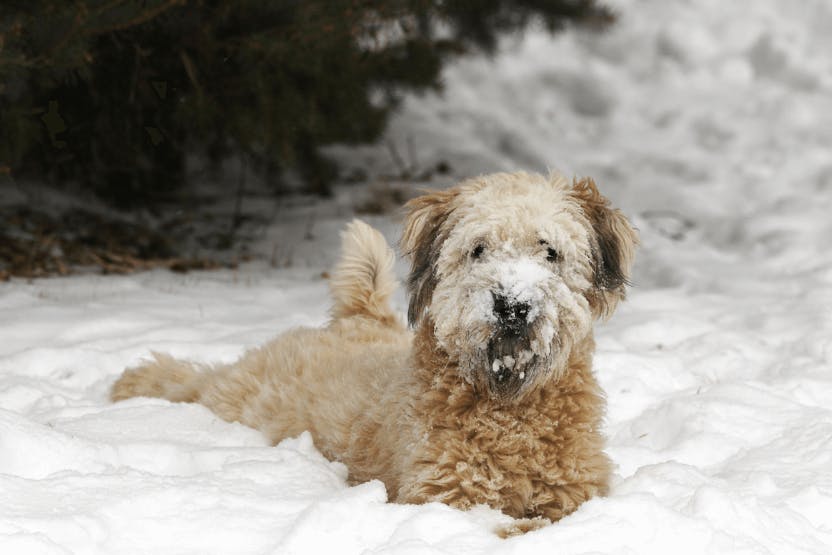- Home
- Dog Wellness
- How Do I Tell if My Dog Has Frostbite?

By Wag! Staff
Published: 01/25/2023, edited: 01/25/2023
More articles by Wag! Staff
Save on pet insurance for your pet
You don't have to choose between your pet and your wallet when it comes to expensive vet visits. Prepare ahead of time for unexpected vet bills by finding the pawfect pet insurance.
- Visible changes in skin color (skin may be bright red, pale, blue, gray, or black)
- Skin that’s frigid to the touch
- Pain in the affected area
- Blisters or sores
- Localized tissue inflammation (swelling)
- Tissue death
- Sloughing off of tissue
- Secondary infections due to open wounds
- Limping on affected paws
- Increased sensitivity to touch in affected areas
- Frostnip (first-degree frostbite) - Mildest type of frostbite that only affects the outermost surface of a dog’s skin and typically only causes skin discoloration (red or pale) and discomfort.
- Superficial frostbite (second-degree frostbite) - Moderate condition that involves the freezing of the top two layers of a dog’s skin. Requires veterinary care for treatment that depends on the symptom severity and whether there are underlying conditions that affect blood flow or wound healing.
- Deep frostbite (third-degree frostbite) - The most dangerous form of frostbite affects the epidermis, dermis, and subcutaneous tissue and requires immediate veterinary care. When these tissues freeze, the cellular fluid inside the dog’s tissue cells harden and burst, resulting in necrosis. Wounds from deep frostbite can develop a bacterial infection. Can be fatal and often requires medication, medical warming procedures, and surgery for tissue removal or amputation.
- The first thing you should do is bring the animal inside and asses them.
- Warm your pet gently and gradually with indirect heating methods like using freshly dried blankets or placing the dog in a lukewarm bath.
- Bundle them up in warm blankets and seek immediate veterinary care once your dog is stable.
- Rub your dog’s skin to dry, warm, or calm them as this can exacerbate tissue damage.
- Put your dog in a hot bath or use hair dryers or heating pads to warm them.
- Place your dog outside after warming them up as this can drastically increase the odds of tissue necrosis.
- Give medication to your pet unless a vet advises you to do so, and never offer them human painkillers like Tylenol, aspirin, or ibuprofen.
- Avoid prolonged exposure to cold weather.
- Limit or avoid taking walks or being outdoors in frigid temperatures.
- Don’t leave Fido in a cold vehicle during the winter months.
- Avoid walking on frozen lakes.
- Invest in dog boots as paws are often the first areas to experience frostbite.
- Get your dog a good-quality waterproof jacket with a hood to protect vulnerable skin and ears.
- Feed your dog high-quality dog food to boost their metabolism and help them combat the cold naturally.
- Keep your dog dry as wet weather and snow put dogs at higher risk of frostbite.
- Make sure your dog has access to fresh water at all times.
- If your dog stays outside, regularly check and refill outdoor water supplies to prevent them from freezing over, provide an insulated shelter with a sturdy foundation to keep them off the ground and thick, warm bedding or an outdoor heated pet bed. You can also provide a heater explicitly made for dog houses, but do not use heat lamps which can cause burns and fires.
- Schedule regular vet visits during the winter months. Arthritis, for instance, can lead to dogs laying down on the cold ground more often which could make dogs more susceptible to frostbite. Dogs with untreated illnesses that affect blood flow, such as heart disease and diabetes, are more likely to get frostbite, according to the Veterinary Centers of America.
- For even more tips on safely walking your dog in the cold, check out 13 Tips for Walking Your Dog in the Winter.
If your dog is at risk of frostbite, start comparing insurance plans from leading insurers like Healthy Paws and Embrace to find the right policy for your pet!

